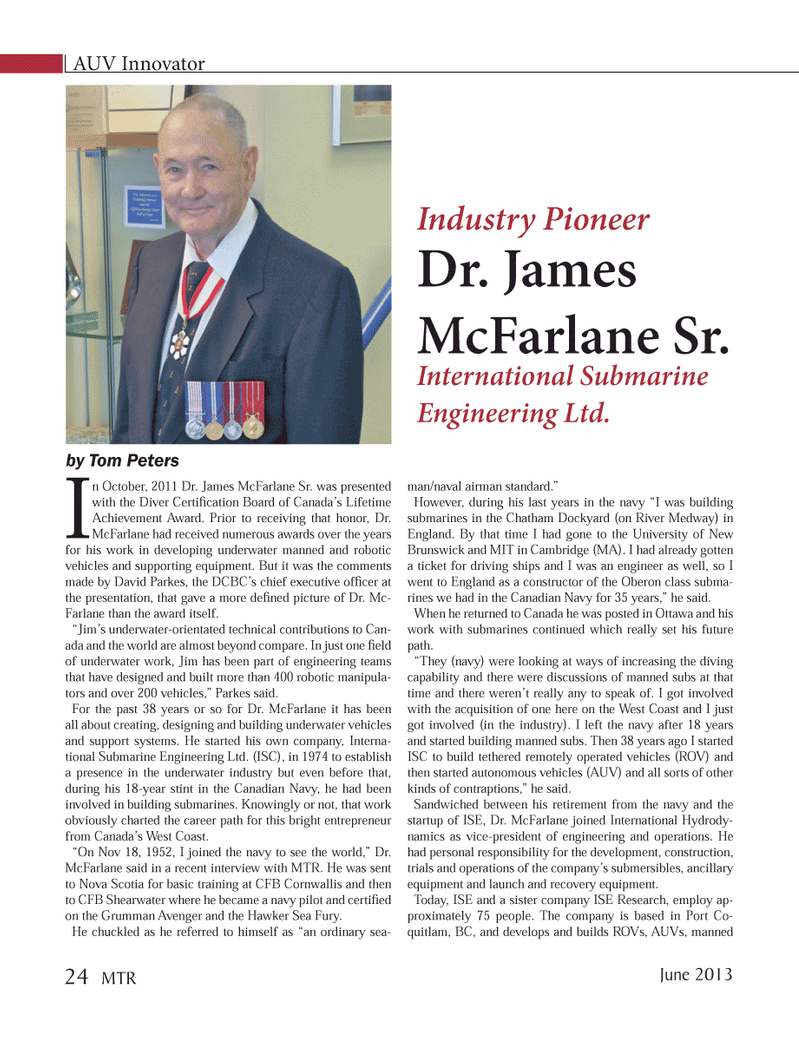
Page 24: of Marine Technology Magazine (June 2013)
AUV Operations
Read this page in Pdf, Flash or Html5 edition of June 2013 Marine Technology Magazine
In October, 2011 Dr. James McFarlane Sr. was presented with the Diver CertiÞ cation Board of CanadaÕs Lifetime Achievement Award. Prior to receiving that honor, Dr. McFarlane had received numerous awards over the years for his work in developing underwater manned and robotic vehicles and supporting equipment. But it was the comments made by David Parkes, the DCBCÕs chief executive ofÞ cer at the presentation, that gave a more deÞ ned picture of Dr. Mc- Farlane than the award itself. ÒJimÕs underwater-orientated technical contributions to Can- ada and the world are almost beyond compare. In just one Þ eld of underwater work, Jim has been part of engineering teams that have designed and built more than 400 robotic manipula- tors and over 200 vehicles,Ó Parkes said. For the past 38 years or so for Dr. McFarlane it has been all about creating, designing and building underwater vehicles and support systems. He started his own company, Interna- tional Submarine Engineering Ltd. (ISC), in 1974 to establish a presence in the underwater industry but even before that, during his 18-year stint in the Canadian Navy, he had been involved in building submarines. Knowingly or not, that work obviously charted the career path for this bright entrepreneur from CanadaÕs West Coast. ÒOn Nov 18, 1952, I joined the navy to see the world,Ó Dr. McFarlane said in a recent interview with MTR. He was sent to Nova Scotia for basic training at CFB Cornwallis and then to CFB Shearwater where he became a navy pilot and certiÞ ed on the Grumman Avenger and the Hawker Sea Fury. He chuckled as he referred to himself as Òan ordinary sea-man/naval airman standard.Ó However, during his last years in the navy ÒI was building submarines in the Chatham Dockyard (on River Medway) in England. By that time I had gone to the University of New Brunswick and MIT in Cambridge (MA). I had already gotten a ticket for driving ships and I was an engineer as well, so I went to England as a constructor of the Oberon class subma-rines we had in the Canadian Navy for 35 years,Ó he said. When he returned to Canada he was posted in Ottawa and his work with submarines continued which really set his future path.ÒThey (navy) were looking at ways of increasing the diving capability and there were discussions of manned subs at that time and there werenÕt really any to speak of. I got involved with the acquisition of one here on the West Coast and I just got involved (in the industry). I left the navy after 18 years and started building manned subs. Then 38 years ago I started ISC to build tethered remotely operated vehicles (ROV) and then started autonomous vehicles (AUV) and all sorts of other kinds of contraptions,Ó he said. Sandwiched between his retirement from the navy and the startup of ISE, Dr. McFarlane joined International Hydrody- namics as vice-president of engineering and operations. He had personal responsibility for the development, construction, trials and operations of the companyÕs submersibles, ancillary equipment and launch and recovery equipment. Today, ISE and a sister company ISE Research, employ ap- proximately 75 people. The company is based in Port Co- quitlam, BC, and develops and builds ROVs, AUVs, manned Dr. James McFarlane Sr. Industry Pioneer International Submarine Engineering Ltd. AUV Innovator by Tom Peters June 201324 MTRMTR #5 (18-33).indd 24MTR #5 (18-33).indd 246/3/2013 1:03:05 PM6/3/2013 1:03:05 PM

 23
23

 25
25
